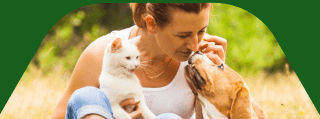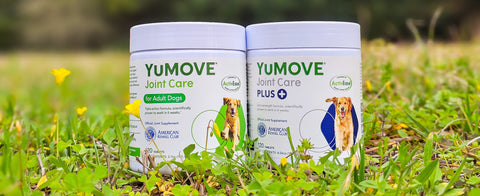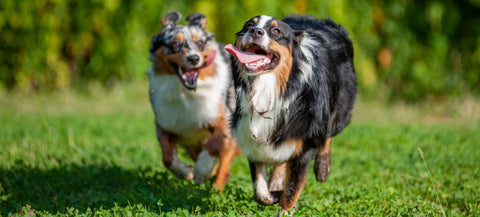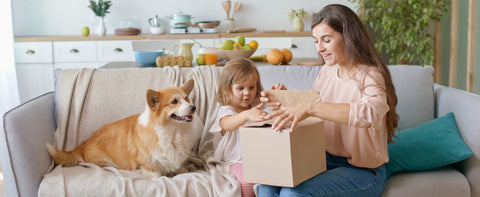We all know Halloween is the spookiest day of the year, but have you ever thought about Halloween from your dog's perspective? Strange little monsters knocking at the door, scary noises, and let’s not forget about those tempting treats in shiny colorful wrappers… it can all add up to an uncomfortable and truly frightening night for your four-legged friend. Here are our top dog calming and safety tips for a happier Halloween for everyone.
Dogs don’t understand the wider context of holidays like Halloween, so though they may usually enjoy meeting visitors, familiar faces can become unfamiliar thanks to costumes, makeup, and wigs. Even confident, well-socialized dogs may find people in costume unnerving or scary.
What’s more, changes to routine – and many door knocks and bell rings – can be unsettling, and there are lots of opportunities for dogs to help themselves to treats they shouldn’t. Let’s take a few minutes to put ourselves in our dogs’ paws and think about how Halloween might feel from their perspective.
Now you’ve got an idea of how your best friend might be feeling over Halloween, how can you spot when they’re feeling stressed or might be in danger? Here are some scenarios and tell-tale signs to look out for:
Is your dog often nervous or fearful?
It’s likely that they’ll find lots of noise, changes around the house and visitors stressful. Nervous dogs show their stress in various ways including:
- Hiding
- Shaking
- Refusing food
- Seeking comfort from you
- Yawning and pacing
- Excessive licking of the lips
- Panting even though they’re not warm
Can they be territorial or possessive of their home?
If your dog is sensitive about their space, trick-or-treaters may not go down well. As well as many knock knocks, doorbell rings, Halloween parties, and surroundings being generally more noisy than normal might upset dogs too. Parties at home – even quiet ones! – can be stressful, so be aware that your dog might not welcome guests as warmly as you do.
Top Tip -
If you have friends or family in a more remote location, it could make sense to let your dog have a little Halloween vacation until things calm down at home.
Does your dog struggle with new things?
Did you know that puppies and dogs who don’t receive appropriate habituation to different situations and objects can develop what behaviorists call “neophobia” – that’s a fear of new things. You can help dogs who aren’t keen on new things by working with a behaviorist – and practically speaking, it makes sense to minimize decorations and keep them away from costumed visitors.
Doggie dos and don’ts at Halloween time
There are some dos and don’ts that apply to all dogs – nervous or not – for a safer, happier Halloween. Here goes…
The ‘don’ts’...
Rain check on Halloween party plans for pooches
Thought you might like the idea of a canine sidekick to complete your Halloween outfit? Your dog is likely to be happier snoozing on the sofa!
Avoid trick-or-treating with your dogEven calm, confident, well-socialized dogs can be frightened of costumes, noises, and crowds of trick-or-treaters, and scared dogs can behave unpredictably – not a risk you want to take around little ones.
Think twice about doggie costumes, even for confident dogsThough some pooches may be OK with comfortable dog-friendly clothes and costumes, many more find dressing up stressful, adding pressure at an already tricky time for dogs. If you’re not 110% sure that you can read even the subtlest signs of stress, avoid the outfits.
Watch out for the treats!Human sweets aren’t great for doggie digestion. Chocolate is poisonous, and these days, many sweets also contain artificial sweeteners. So, as well as an upset tummy, you may end up having to make an emergency trip to the Vet if your dog finds their way into your Halloween candy stash. Same goes for decorations that may double as toys.
The ‘do’s’...
Got a nervous dog? Start dog calming prep nowIf your dog is nervous or shy, now's the time to start working with them to make Halloween – and fireworks night – a less stressful time. We’d recommend talking to your vet or a certified behaviorist to work out a behavior modification program. This might include positive reinforcement exercises to build their confidence around scary or new things or using natural calming supplements.
Get some ideas for dog calmingThere are many ways to help nervous dogs feel calmer. From cuddles to extra exercise, there are easy and practical ways you can help.
Give them a safe space away from the human funCreating a calm, quiet area where your dog can retreat is a great idea on Halloween. Set it up a few days before you expect your first Halloween visitors and help your dog build positive associations by giving treats or stuffed in this safe place.
How to build a den…
- Choose the right spot – as far away from your main door as possible. A quiet bedroom, bathroom or utility room is ideal
- Now make a cave – a large box or crate covered in blankets or duvets, or for big dogs, how about under the dining table!
- Bring in familiar things – move their bed to the area (don’t wash the bedding), and maybe add an old sweater or t-shirt that you’ve slept in for a few days.
Swap your evening walk for a daytime adventure to minimize the chance of running into trick-or-treaters in scary costumes and spooky decorations. And when it’s time for a late-night potty break, be sure to keep your dog on a leash, even if your backyard is fenced – if something spooks them, they may bolt. Scared dogs have been known to clear 6ft fences, so better safe than sorry.
Try some soothing soundsDid you know that you can find playlists to calm excited or stressed pets? We like the Relaxation Music For You & Your Dog playlist on Spotify – all profits go to the Collie Rescue.
So that’s our guide to a happier Halloween for you and your dog – what do you think? Does your dog get spooked at Halloween? Or maybe you’ve had some ghostly encounters together? We’d love to hear what’s happening with you and your best friends! Share your doggie ghost stories, feedback and ideas to help with dog calming in the comments below.











